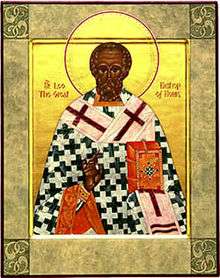Patriarch of the West
Patriarch of the West was on several occasions between AD 450 and 2006 one of the official titles of the bishop of Rome, as patriarch and highest authority of the Latin Church. The title no longer appears among the official ones, starting from the publication of the 2006 Annuario Pontificio.[1][2][3]

History
The origin of the definition of the patriarch of the West is linked to the unhinging of the ancient system based on the three apostolic centers of Rome, Antioch (both founded by Saint Peter) and Alexandria (founded by Saint Mark, the disciple of Peter) and the constitution, with the First Council of Constantinople in 381 and the Council of Chalcedon in 451 and despite the papal opposition, of the new Pentarchy,[4] with the elevation of the Patriarchate of Constantinople and Jerusalem.[5][6] In this system, with the exception of Rome, the other four patriarchates fell under the authority of the Byzantine Empire and came to conform as territorially well defined entities. Rome, on the other hand, became the seat with authority over the territories of the Western Roman Empire.
In 450, the Byzantine Emperor Theodosius II addressed himself in a letter to Pope Leo I, mentioning him as a patriarch explicitly for the West (this is the first mention of a pope in this capacity). When the Western Roman Empire collapsed in 476 and extended by Justinian I the eastern legislation on Rome with the Pragmatic sanction of 554,[7] the imperial ecclesiastical system of the Pentarchy found complete application. In 642, while the Byzantine Emperors also imposed the support for Miaphysitism on the popes, Pope Theodore I formally assumed for the first time the title of patriarch of the West.[8][9][10][11]
Renunciation
On 22 March 2006, the Vatican released a statement explaining the omission of the title from the Annuario Pontificio on the grounds of expressing a "historical and theological reality" and of "being useful to ecumenical dialogue". The title patriarch of the West symbolized the pope's special relationship with, and jurisdiction over, the Latin Church—and the omission of the title neither symbolizes in any way a change in this relationship, nor distorts the relationship between the Holy See and the Eastern Churches, as solemnly proclaimed by the Second Vatican Council.[12]
Notes
- Luigi Accattoli, Il Papa non è più «Patriarca dell'Occidente», Corriere della Sera, 1º marzo 2006
- Adriano Garuti, "Il papa patriarca d'Occidente? Studio storico dottrinale", Edizioni Francescane, Bologna 1990
- Joseph Ratzinger, Il nuovo popolo di Dio, Editrice Quriniana, Brescia
- "Quinisext Council". Encyclopædia Britannica. Retrieved 14 February 2010. "The Western Church and the Pope were not represented at the council. Justinian II, however, wanted the pope as well as the Eastern bishops to sign the canons. Pope Sergius I (687–701) refused to sign, and the canons were never fully accepted by the Western Church".
- Deno John Geanakoplos, Byzantium: Church, Society, and Civilization Seen Through Contemporary Eyes (University of Chicago Press, 1984), p. 203
- A.P. Vlasto, The Entry of the Slavs into Christendom (Cambridge University Press, 1970, p. 308
- J. F. Haldon, Byzantium in the seventh century (Cambridge, 2003), 17–19.
- Meyendorff, John (1983). Byzantine Theology: Historical Trends and Doctrinal Themes (Revised 2 ed.). New York: Fordham University Press.CS1 maint: ref=harv (link)
- Meyendorff, John (1989). Imperial unity and Christian divisions: The Church 450–680 A.D. The Church in history. 2. Crestwood, NY: St. Vladimir's Seminary Press.CS1 maint: ref=harv (link)
- Ostrogorsky, George (1956). History of the Byzantine State. Oxford: Basil Blackwell.CS1 maint: ref=harv (link)
- Allen, Pauline: "Sophronius of Jerusalem and Seventh Century Heresy" Oxford University Press 2009
- "Communiqué concernant la suppression du titre "Patriarche d'Occident" dans l'Annuaire pontifical 2006". Vatican.va. Retrieved 11 August 2010.
